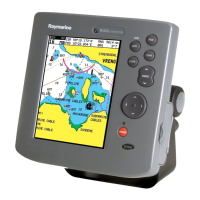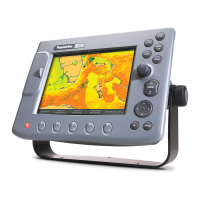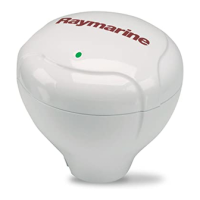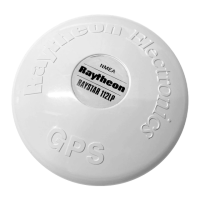Frequencyadjustment(CHIRPsonarmodulein
non-CHIRPmode)
WhenusingaCHIRPsonarmoduleinCHIRPmode(LowChirp,
MedChirporHighChirp)thefrequencycannotbeadjusted.When
usingaCHIRPsonarmoduleinanon-Chirpmode(e.g.50kHz
or160kHz)thefrequencyatwhichthetransduceristransmitting
canbeadjusted.
WiththeCHIRPsonarmodulesettoaCHIRPmode(e.g.LowChirp
orHighChirp)theCHIRPsonarmodulewillsweepthetransducer’s
availablefrequencyrangeineachping.
WiththeCHIRPsonarmodulesettoanon-CHIRPmode(e.g.50
kHzor160kHz)theCHIRPsonarmodulecanadjustthefrequency
atwhichthetransduceristransmitting.Theadvantagesofbeing
abletoadjustthetransmitfrequencyinclude:
•Optimizationforparticularspeciesofshandwaterconditions.
•Avoidinginterferencefromothersonaroperatingnearby(atthe
samefrequency).
•Useofwideornarrowbeamonaparticulartransducer.
Thegraphbelowdepictstheadjustment(selectionofaspecic)
frequencywhenusingaCHIRPsonarsetto160kHz.
CHIRPsonarmodulefrequency
1.Frequencyadjustmentrange.
2.Transducercharacteristics.
3.Operating(center)frequency.
Adjustingtheshnderfrequency(CHIRPsonarmodulein
non-CHIRPmode)
WhenconnectedtoaCHIRPsonarmodulesettoanon-CHIRP
modeyoucanmanuallyadjustthetransmitfrequency.
Fromtheshnderapplication:
1.selectMenu.
2.SelectFrequencysettings.
3.SelecteitherTuneFreq1orTuneFreq2asrequired.
TheFrequencyadjustsliderbarisdisplayed:
4.Adjusttheslidertotherequiredvalue.
5.SelectBacktoclosetheadjustfrequencysliderbar,or
6.SelectOktosettheadjustfrequencytoautomatic.
Note:Whenmanuallyadjustingthefrequencytheactual
frequencyofoperationisnotdisplayed,theshnderapplication
titlebardisplaysthetransducerscenterfrequency.
Usingtheshnder
179

